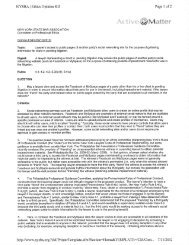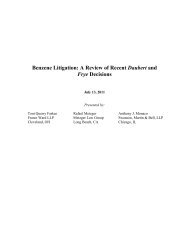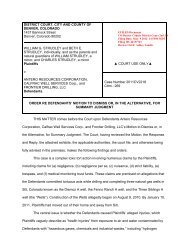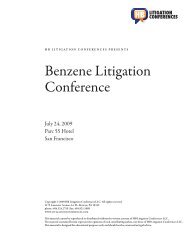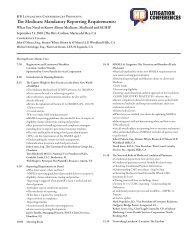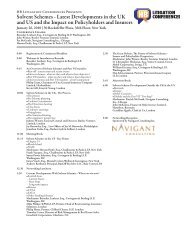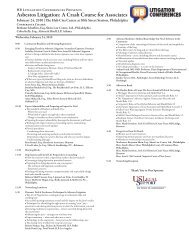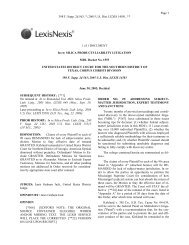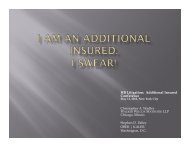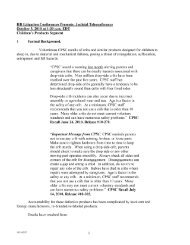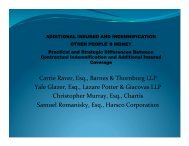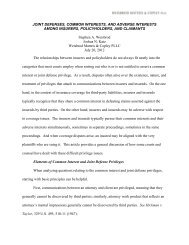Is My Drywall Chinese? - HB Litigation Conferences
Is My Drywall Chinese? - HB Litigation Conferences
Is My Drywall Chinese? - HB Litigation Conferences
You also want an ePaper? Increase the reach of your titles
YUMPU automatically turns print PDFs into web optimized ePapers that Google loves.
SUITE 650, FOURTH AVENUE<br />
SEATTLE, WASHINGTON 98121<br />
PHONE 206-623-2935 FAX 206-623-2985<br />
HTTP://WWW.GREENFIELDADVISORS.COM<br />
<strong>Chinese</strong> <strong>Drywall</strong><br />
A Greenfield Advisors White Paper<br />
John A. Kilpatrick, Ph.D., MRICS and Christopher A. Miner, MAI<br />
June 5, 2009<br />
The <strong>Chinese</strong> <strong>Drywall</strong> issue is rapidly unfolding,<br />
and Greenfield Advisors has been tracking the<br />
issues since they first came to light. The<br />
following is based on the best information<br />
available to date, which is believed to be<br />
reliable<br />
In 2005, a spike in housing construction<br />
appeared in the southeastern United States as a<br />
result of major hurricanes in the previous year.<br />
Coupled with the booming housing market, this<br />
led to a shortage of raw material including<br />
drywall. To cope with this demand, non‐<br />
standard sources of drywall were sought out<br />
(much of the normal US drywall allotment<br />
comes from Canada and Mexico). Knauf<br />
International GmbH fulfilled this demand to a<br />
large extent by manufacturing and importing<br />
drywall from China, to the tune of 500 million<br />
pounds in 2006, up from less than 2 million<br />
pounds imported in 2005. By 2007 an easing of<br />
the housing boom reduced these imports to 33<br />
million pounds, although that is still enough to<br />
affect thousands of homes.<br />
The <strong>Chinese</strong> drywall was made using fly ash, the<br />
residue from coal‐burning power plants. Fly ash<br />
contains many dangerous compounds<br />
(chromium, lead and arsenic among others). So<br />
far, the only reported impact on human health<br />
has been attributed to the sulfur‐based gas that<br />
the drywall emits. This gas also corrodes<br />
(oxidizes and pits) copper building components.<br />
Initially this corrosive and caustic gas was<br />
thought to be sulfur‐dioxide, but it has since<br />
been determined to be mostly carbon<br />
disulphide, carbonyl sulfide and strontium<br />
sulfide. 1<br />
As homes from 2006 began to age a bit, those<br />
built with this <strong>Chinese</strong> drywall began to<br />
manifest problems, notably rotten egg (sulfur)<br />
smells and corroding copper plumbing, copper<br />
heat exchanger coils, and exposed copper<br />
wiring. Scores of lawsuits have cropped up as<br />
people noticed the pattern and came to the<br />
conclusion that the <strong>Chinese</strong> drywall was<br />
contaminated and defective.<br />
The extent of the problem spans many states.<br />
At least two major home builders (Ryland and<br />
Lennar) have attempted to remediate the<br />
problem by replacing the sheetrock and the<br />
more obviously corroded components in<br />
customers’ homes.<br />
The purpose of this paper is to raise the<br />
awareness among real estate professionals<br />
about this issue and to provide them with tools<br />
to help them identify homes with this faulty<br />
drywall. It also provides some background on<br />
how some forms of impairment can cause<br />
losses in value above the cost to cure, which is<br />
referred to as ‘stigma’ in the real estate lexicon.<br />
The paper also outlines some of the valuation<br />
techniques that can be used to determine how<br />
defective drywall impacts value.<br />
At this time, new information regarding<br />
<strong>Chinese</strong>‐made drywall is still being discovered.<br />
This paper summarizes the information that we<br />
know so far.




